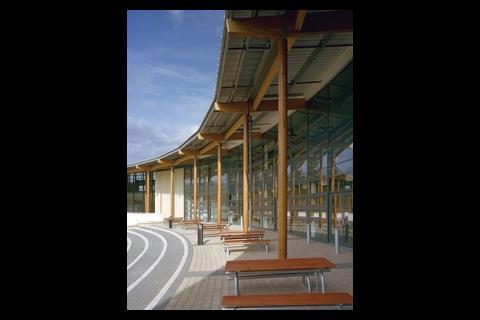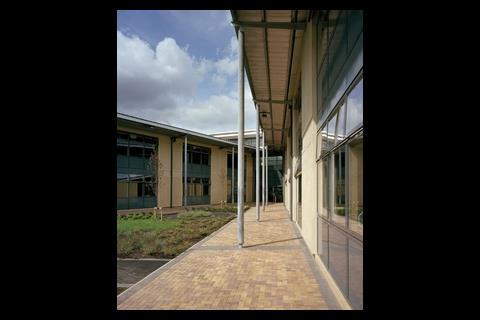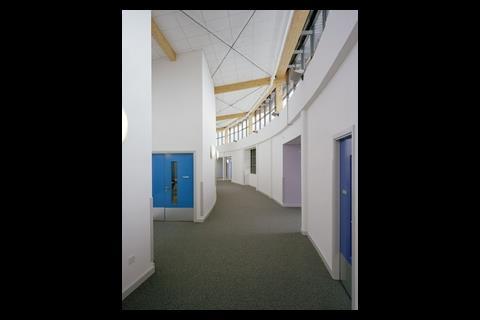Four schools, a leisure centre, a library and even a theatre have been created on a single site at the Hadley Learning Community. As Paul Haddlesey finds out, the project is also big on natural ventilation and greywater recycling
The Hadley Learning Community in Telford is a first for the UK. On a site that was originally only home to an infant and junior school, both in dire need of extensive refurbishment, now stands a primary school for 420 pupils, a secondary school for 1200 and a school for 150 children with severe and profound learning difficulties. That’s not all. On top of this is a 50-place early education and childcare facility, a sports and leisure centre, a library and an arts centre. What makes it a first is that all these facilities are under one roof.
Together they create a single, integrated building. Each of these structures radiates from a central open-space hub, like the spokes of a bicycle wheel. The complex comprises a mixture of single- and two-storey spaces, which provide about 30,000 m2 of floor space in a structure that has a total diameter of 400 m. The central hub, which includes a 150-seat performance space, has a diameter of 100 m.
In order to satisfy the client’s aspirations for a sustainable building, consulting engineer Faber Maunsell designed a structure that would have a high thermal mass, and that would also be cost-effective to construct. As a result, the building has a reinforced concrete roof, constructed using welded mesh rather than loose laid bars. This enabled the roof to be built more quickly, making it cost-competitive with a lightweight roof.
More time was saved by adopting a modular approach for other structural elements. So, for example, all of the spans are identical. Similarly, modular pre-cast cladding was used for the perimeter. This shared the same dimensions as the curtain walling, so cladding and walling were interchangeable, providing a high level of flexibility for positioning windows. All of these elements were prefabricated off site to reduce on-site assembly times, enabling the entire structure to be erected in less than a year.
Exploiting the high thermal mass of the building, natural ventilation via opening windows is used in the majority of areas, with split-system air conditioning in a few spaces with high thermal loads. During the summer months, the building will be flushed through with outside air at night to cool the structure and minimise heat gains during the following day.
Silent treatment
As Faber Maunsell project director Simon Curtis recalls, making use of natural ventilation at the same time as meeting strict requirements for noise levels was something of a challenge. “The proximity of a main railway line to the school meant we had to consider noise levels very carefully. As well as positioning the direction of opening windows to minimise noise intrusion, we also constructed a 5m high bund to absorb noise from the railway line,” he explains.
Heating is provided through underfloor systems, though there are additional heating demands for domestic hot water and the swimming pool. The base heating load is met with an 850 kW biomass boiler, using a mixture of wood pellets and chips sourced from a local short-rotation coppice plantation.
During peak demand, the biomass boiler is supplemented by gas-fired condensing boilers, exploiting the relatively low return water temperatures from the underfloor heating to achieve maximum condensing.
Adding to the sustainable nature of the building is a greywater recycling system, so that wastewater from the building can be reused for flushing toilets and irrigating the surrounding garden spaces.
Another major challenge of the design was to achieve high levels of security while also encouraging local people to make full use of the facilities. Security measures had to protect both the buildings and the children, while maintaining a welcoming ambience for visitors. This has been achieved using sophisticated access control systems linked to identity cards for regular users, with a welcoming reception layout for occasional users.
The project was procured through a PFI contract between the Borough of Telford and Wrekin and Interserve and is due to be fully operational by January 2007. It’s a pioneering design, which is destined to form the basis of similar projects in other parts of the country. Both the performance of the building and its use by the community are sure to be the subject of much scrutiny in coming years.
Source
Building Sustainable Design

























No comments yet